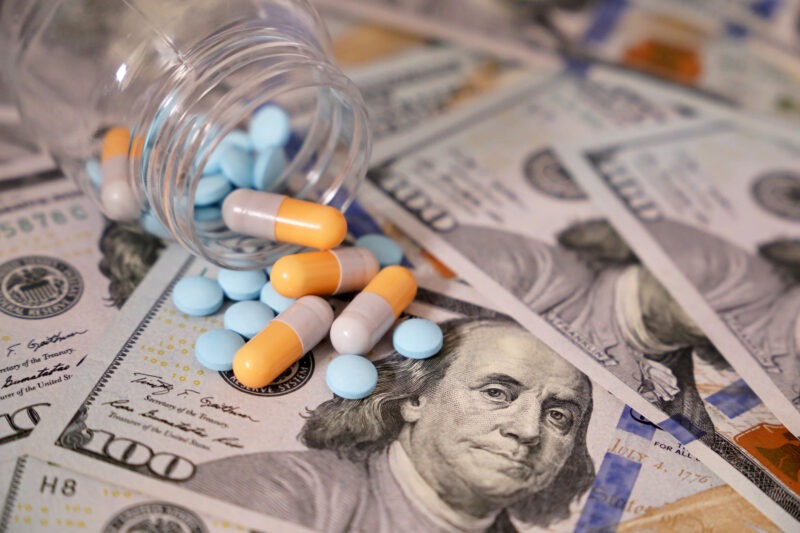US Bio/Pharma Market: Is Stronger Growth Ahead?
The US bio/pharma market showed positive signs in 2023, despite a decline in spending on COVID-19 vaccines and products. Overall, the US market grew by 2.3% last year, and by 9.9%, excluding COVID-19 products. What’s projected in the near term?
Crunching the numbers
Overall spending in the US market for medicines grew 2.5% in 2023, reaching $435 billion at net price levels, reflecting a sharp decline in spending for COVID-19 vaccines and therapeutics, according to a recent analysis by the IQVIA Institute for Human Data Science, The Use of Medicines in the US 2024: Usage and Spending Trends and Outlook to 2028. Spending growth was 9.9% when COVID-19 vaccines and therapeutics were excluded, driven by innovation in therapeutic areas such as oncology, immunology, diabetes, and obesity.
“This is a story of two countervailing trends: A sharp decline in the use of COVID-19 vaccines and therapies, which is offset by a shifting usage pattern and a rapid acceleration in spending growth driven by innovation that is bringing more effective medicines to more patients,” said Murray Aitken, Executive Director of the IQVIA Institute for Human Data Science, in commenting on the study. “Over the next five years, we can expect continued growth in spending on medicines in the US driven by innovation, but offset by notable expiration events and biosimilar introductions.”
Total medicines spending in the US grew $10.4 billion in 2023, driven primarily by $19 billion in spending on new brands, a $22-billion impact on changes in the mix of medicines toward higher value medicines, and offset by a $28-billion decline in COVID-19 spending and a $17-billion impact from patent expiries. Spending at list prices has increased faster than all-payer net spending but far slower than the spending eligible for 340B discounts, which includes children’s hospitals, cancer and safety net hospitals, and which are entitled to purchase at the lowest prices in the market. Variations in growth at differing price levels highlight the complex interaction between list prices and the varied discounts applicable to different stakeholders, according to the IQVIA Institute analysis.
A continued trend is the rise of specialty medicines. In the US market, specialty medicines account for 54% of spending, up from 49% in 2018, driven by growth in immunology and oncology while traditional therapies have gained share recently from rising spend in diabetes, obesity, and vaccines. Specialty medicines, as defined by the IQVIA Institute, are those medicines that treat chronic, complex, or rare diseases and possess additional distribution, care delivery, and/or cost characteristics, which require special management by stakeholders.
Key trends
In looking at the US bio/pharma market based on medicine use, in 2023, total prescription medicine use increased by 4% and reached 210 billion days of therapy. Non-retail medicine use, including a large portion of cancer treatments, was disrupted early in the pandemic but has seen a sharp rise, especially in clinics and doctors’ offices. Retail prescriptions reached 6.9 billion, a 2.9% increase from 2022 and down slightly from the prior year. Many therapy areas had high growth in days of therapy in 2023, including glucagon-like peptide-1 (GLP-1) agonists in obesity and diabetes, immunology treatments, lipid regulators, and gastrointestinal medicines, all of which had increased use of more than 9% in 2023. according to the IQVIA Institute analysis.
Another positive sign for the US bio/pharma market was an uptick in new prescriptions despite declines in other healthcare services. The IQVIA Health Services Utilization Index, which was developed to provide a composite view of multiple types of health services over time, tracks patient visits, screenings and diagnostic tests, elective procedures, new prescriptions, and vaccinations. The Index fell to 97 for 2023, a decline of 3% from 2022, reflecting a 4-6% reduction across all indicators except for new prescriptions, which were up 4%. New prescriptions for chronic and acute conditions were both above pre-pandemic levels in 2023, reflecting continued growth of chronic prescriptions and a resurgence of seasonal respiratory ailments driving higher acute prescriptions. Flu vaccination rates fell by 17% from the 2022 level, and other routine adult and pediatric vaccination rates remain below pre-pandemic levels.
Another factor to consider in evaluating the US market are patient out-of-pocket costs, which increased due to the increasing use of GIP/GLP-1 agonists, which are approved and widely reimbursed for diabetes but are less commonly covered for obesity. In aggregate, patient out-of-pocket costs reached $91 billion in 2023, an increase of $5 billion over the prior year. This amount is after $23 billion in copay assistance programs provided by manufacturers, with patients using copay cards for nearly one-third of brand commercial prescriptions in the top 10 therapy areas and 63% of obesity prescriptions, according to the IQVIA Institute analysis. Out-of-pocket costs have risen for both commercial and Medicare (the US government healthcare program for individuals 65 or older) patients while the amount paid by uninsured patients has declined due to a smaller uninsured population—even as rising list prices have exposed them to higher costs. More than 90% of prescriptions costed patients less than $20, but 1%, or 71 million prescriptions, exceeded $125.
US bio/pharma market outlook
In looking at the US bio/pharma market through 2028, the US medicines spending forecast reflects continued growth driven by innovation, offset by notable expiry events. The next five years are expected to bring an increasing gap between list price spending, which will grow at 6-9%, and manufacturer net revenues, which will grow at 4-7%, including the expected impacts of price negotiation and other aspects of the Inflation Reduction Act, key legislation in the US, which for the first time allows the US government to negotiate the price of select drugs under Medicare. The process for implementing the new law began last year (2023), and the first negotiated prices are set go into effect in 2026 for the first 10 drugs selected for price negotiation.
Overall, new brand spending in the US is projected to total $122 billion over the next five years (through 2028), down from the $149 billion in the period 2018–23, according to the IQVIA Institute analysis. Net prices for protected brands are forecast to decline -1 to -4%. The impact of exclusivity losses will increase to $93.6 billion over five years, including significant contributions from new biosimilars.
In looking at US bio/pharma market growth on a therapeutic sector basis, oncology and obesity products will drive growth through 2028 while diabetes, immunology, and COVID-19 products will contribute to decline, according to the IQVIA Institute analysis. Net spending on diabetes will be flat to 2028 as wider adoption of novel therapies is offset by both list and net price cuts. Immunology spending growth is expected to slow to 2-5% through 2028 from the impact of biosimilars while volume increases 75% over the same period. Next-generation biotherapeutics, including cell and gene and RNA therapies, are expected to reach $18 billion by 2028, more than 3.5 times the current level.







